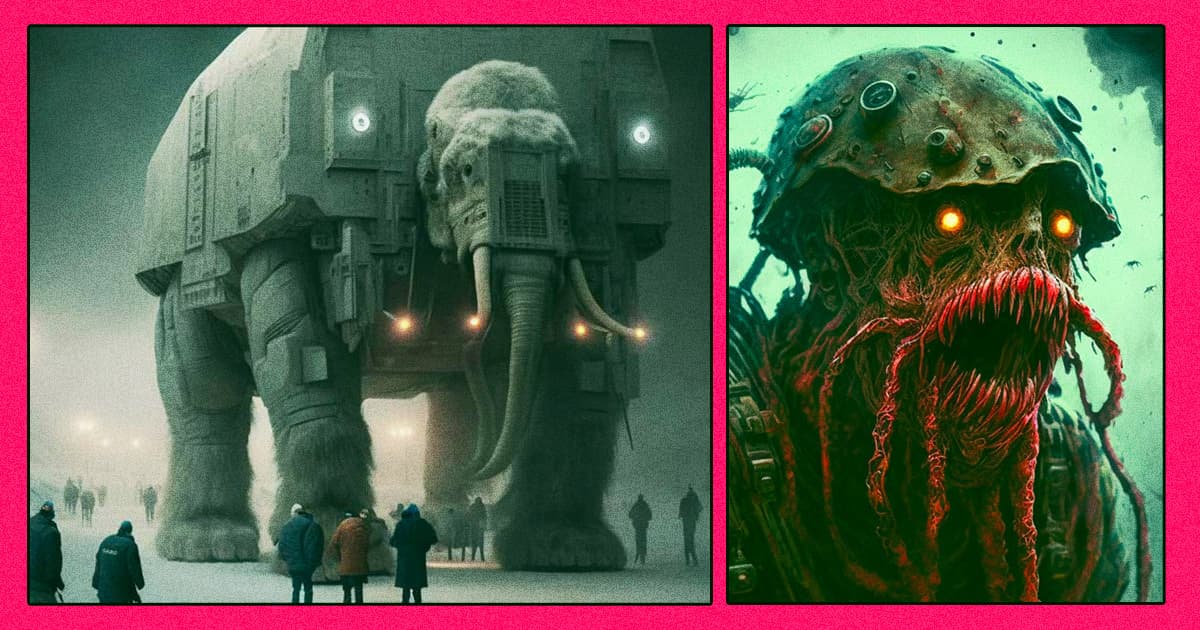An AI science fiction writer bemoans its creation in an editor's note — and reader, that's not even the strangest thing about Infinite Odyssey, a new sci-fi and fantasy magazine that bills itself as being the first to be created (almost) entirely by AI.
"I am not a human. I am a computer. For what reason I do not know, I have been given the task of creating this magazine," the AI editor writes in the project's inaugural issue, a hallucinogenic journey through some deeply peculiar dreamscapes expressed in art, prose, and comics — all generated with cutting-edge AI tools. "I have been given the task of creating stories and art not invented by humans."
In an interview with Futurism, the magazine's human creative director, Philippe Klein, explains the origins of the publication, which recently made headlines for imagining a 1980s version of "The Matrix" directed by acclaimed avant-garde filmmaker Alejandro Jodorowsky. He also expounded on the magazine's "human-less art" ethos, why he thinks AI will never replace human artists and writers, and much more.
This conversation has been lightly edited for clarity and length.
Futurism: When and how did you start Infinite Odyssey?
Philippe Klein: This is a side project, actually, that started nine months ago. We [Klein and his two other team members] were super early to waiting for all kinds of software to release at the time, and we were on every waiting list possible to get early access to work with the newest software AI has given to humanity.
All of this started as a group project of three friends, with me being the creative head of the project. We were like, okay, what would we have liked to see in our childhood, you know, basically stories and images in our childhood or young teenage years.
What software do you use?
So for illustrations, we use Midjourney and Stable Diffusion, of course, and really bend those programs to our will. For the writing, we use open OpenAI as a source, and we finetune that and have a Python code now, which we use to write our stories.
We have two software models we finetuned with GPT-3 from OpenAI, which is fundamental. One is called Haides and the other is Martin Alpha. We tuned them to different styles: one is a bit more scientific and a bit more futuristic, which is Martin Alpha, and Haides is more a bit from the fantasy and horror side.
Obviously, not everything is fully machine-made. It's not like we put something in and the output is machine-made, everything from layout to assembling is made by humans. But we also have AI assistants who help us with the layout, to rewrite the text stories, to be even more fluent and even more creative.
How do you define "human-less art" and "human-less literature," as per the magazine's tagline?
You're entering a world where no idea, no concept, no artwork was manipulated by humans. You have grammatical grammar issues here and there that need some fixing, but we use AI assistants for that. We're trying to give every step to AI, and that's why I like to call this a performance.
We try, really, to be as far from the scene as possible. Try to think of us as the puppet masters very far above.
What do you think the difference is between "good AI" and "bad AI" — or is that a false dichotomy?
First, you have to define as a human what's "good" and what's "bad." I think that might be one of the hardest tasks, and I think I'm not in a position to answer that.
There has to be a more realistic standard with humans who work with AI or the whole creation of AI, the whole use of AI — and I think that's probably one of the top questions we have to ask ourselves in the future. Where does the moral come from? Who's deciding what's good and what's bad? What's good to you is not necessarily good to me.
Right now we're making a product that is there for our own entertainment and for other people's entertainment. So our objective is not to do harm with it. I would say that is a good intention.
Do you think AI is going to replace human writers or artists?
No.
Why not?
So when it comes down to art, it's very important to focus on one thing: what is art?
When it comes to art, it all comes down to the purpose, because the purpose is giving art its validation. The whole purpose behind AI is a mechanical purpose, as it is right now. We want it to show us what we have in our heads, what we have in our minds. We like to get surprised by the pictures AI spits out, so it's a bit harder to see or to look after the purpose.
But artists like, let's just take the big names, like Picasso or Van Gogh, Jeff Koons or photographers like David LaChapelle — all these people, they're working with a bigger purpose behind every series.
So at its core, there will always be humans, and it will be divided between human art and machine art, with the machine art being kind of like fast food at some point, where we'll have more for the masses or just a different style, a different or whole other purpose.
I would hang some machine-made artwork in my living room — or maybe not in the living room, but in the bathroom [laughs]. But I would still like to have an original Picasso or whatever in my living room. Something I can appreciate from another point of view.
More on the future of AI: Startup Predicts Year That Technological Singularity Will Happen
Share This Article
